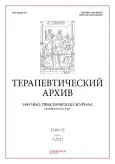Clinical and angiopulmonographic association in pulmonary embolism
- Authors: Mazur E.S.1, Mazur V.V.1, Rabinovich R.M.2, Bachurina M.A.2
-
Affiliations:
- Tver State Medical University
- Tver Regional Hospital
- Issue: Vol 93, No 4 (2021)
- Pages: 363-368
- Section: Original articles
- URL: https://journals.rcsi.science/0040-3660/article/view/71154
- DOI: https://doi.org/10.26442/00403660.2021.04.200674
- ID: 71154
Cite item
Full Text
Abstract
Aim. To detect the effect of the feature of the pulmonary vascular obstruction on the clinical manifestations of pulmonary embolism (PE).
Materials and methods. The 127 patients with PE were included in this study. PE verified with multidetector computed tomography with pulmonary angiography. Among them were 57 patients with high-risk PE, and 39 patients with intermediate-risk PE and 31 patients with low-risk PE. The pulmonary artery obstruction index and the obstruction level were determined.
Results. The mean values of the pulmonary artery obstruction index in high and intermediate risk patients were 42.5%, and in low risk patients – 12.5% (p<0.001). The trunk or main branches obstruction was in 80.7% of high-risk PE patients, the main or lobar branches obstruction – in 92.3% of intermediate-risk patients and lobar or segmental branches obstruction – in 93.5% of low-risk patients. Pulmonary infarction was detected in 89.2% of patients with the segmental branches obstruction and with another level of obstruction – in 28.0% of patients only (p<0.001).
Conclusion. The hemodynamic disorder in pulmonary embolism associate with the pulmonary artery obstruction index of more than 30%. The development of obstructive shock is associated with the pulmonary artery trunk obstruction, and the development of pulmonary infarction associated with the segmental branches obstruction.
Full Text
##article.viewOnOriginalSite##About the authors
Evgeniy S. Mazur
Tver State Medical University
Author for correspondence.
Email: mazur-tver@mail.ru
ORCID iD: 0000-0002-8879-3791
д.м.н., проф., зав. каф. госпитальной терапии и профессиональных болезней
Russian Federation, TverVera V. Mazur
Tver State Medical University
Email: mazur-tver@mail.ru
ORCID iD: 0000-0003-4818-434X
д.м.н., проф. каф. госпитальной терапии и профессиональных болезней
Russian Federation, TverRobert M. Rabinovich
Tver Regional Hospital
Email: mazur-tver@mail.ru
ORCID iD: 0000-0002-1562-6212
к.м.н., зав. кардиологическим отд-нием с палатой интенсивной терапии и реанимации
Russian Federation, TverMariya A. Bachurina
Tver Regional Hospital
Email: mazur-tver@mail.ru
ORCID iD: 0000-0002-5556-3076
врач-пульмонолог отд-ния аллергологии-иммунологии с пульмонологическими койками
Russian Federation, TverReferences
- Konstantinides SV, Torbicki A, Agnelli G, et al. 2014 ESC Guidelines on the diagnosis and management of acute pulmonary embolism. Eur Heart J. 2014;35:3033-80. doi: 10.1093/eurheartj/ehu283
- Vedovati MC, Becattini M, Agnelli G. Multidetector CT scan for pulmonary embolism: embolic burden and clinical outcome. Chest. 2012;142(6):1417-24. doi: 10.1378/chest.11-2739
- Немирова С.В., Кацубо Л.Б., Кринина И.В., и др. Частота формирования легочно-плевральных осложнений острой тромбоэмболии легочных артерий по данным компьютерной томографии. Медицинский альманах. 2015;3(38):68-72 [Nemirova SV, Katsubo LB, Krinina IV, et al. The frequency of the formation of pulmonary and pleural complications of pulmonary embolism according to computed tomography. Meditsinskii al’monakh. 2015;3(38):68-72 (In Russ.)].
- Тромбоэмболия легочной артерии: руководство. Под ред. С.Н. Терещенко. М.: ГЭОТАР-Медиа, 2010 [Pulmonary embolism: a guide. Ed. SN Tereshchenko. Moscow: GEOTAR-Media, 2010 (In Russ.)].
- Крукович А.А, Примак Н.В., Захарчук Н.В., Мокшина М.В. Тромбоэмболия легочной артерии: вопросы диагностики и прогноза. Тихоокеанский мед. журн. 2017;4:31-7 [Krukovich AA, Primak NV, Zacharchuk NV, Mokshina MV. Pulmonary thromboembolism: diagnostics and prognosis. Tikhookeanskii med. zhurn. 2017;4:31-7 (In Russ.)]. doi: 10.17238/PmJ1609-1175.2017.4.31-37
- Stein PD, Fowler SE, Goodman LR, et al. Multidetector computed tomography for acute pulmonary embolism. N Engl Med. 2006;354(22):2317-27. doi: 10.1056/NEJMoa 052367
- Qanadli SD, Hajjam MEl, Vieillard-Baron A, et al. New CT index to quantify arterial obstruction in pulmonary embolism: comparison with angiographic index and echocardiography. AJR Am J Roentgenol. 2001;176(6):1415-20. doi: 10.2214/ajr.176.6.1761415
- Becattini C, Vedovati MC, Agnelli G. Prognostic value of troponins in acute pulmonary embolism: a meta-analysis. Circulation. 2007;116(4):427-33. doi: 10.1161/CIRCULATIONAHA.106.680421
- Masotti L, Righini M, Vuilleumier N, et al. Prognostic stratification of acute pulmonary embolism: focus on clinical aspects, imaging and biomarkers. Vasc Health Risk Manag. 2009;5:567-75. doi: 10.2147/vhrm.s4861
- Smulders YM. Pathophysiology and treatment of hemodynamic instability in acute pulmonary embolism: the pivotal role of pulmonary vasoconstriction. Cardiovasc Res. 2000;48(1):23-33. doi: 10.1016/S0008-6363(00)00168-1
- Савельев В.С. Флебология. Руководство для врачей. М.: Медицина, 2001 [Savel’ev VS. Phlebology. A guide for doctors. Moscow: Meditsina, 2001 (In Russ.)].
- Тюрин И.Е. Тромбоэмболия легочной артерии: возможности лучевой диагностики. Атмосфера. Пульмонология и аллергология. 2005;4:20-4 [Tyurin IE. Pulmonary embolism: radiation diagnostics. Pulmonology and allergology. 2005;4:20-4 (In Russ.)].
- Carrier M, Righini M, Wells PS, et al. Subsegmental pulmonary embolism diagnosed by computed tomography: incidence and clinical implications. A systematic review and meta-analysis of the management outcome studies. J Thromb Haemost. 2010;8(8):1716-22. doi: 10.1111/j.1538-7836.2010.03938
- Stein PD, Goodman LR, Hull RD, et al. Diagnosis and management of isolated subsegmental pulmonary embolism: review and assessment of the options. Clin Appl Thromb Haemost. 2012;18(1):20-6. doi: 10.1177/1076029611422363
- Юдин А.Л., Учеваткин А.А., Афанасьева Н.И., и др. Методические особенности МДКТ-ангиографии и МДКТ-ангиопульмонографии. Медицинская визуализация. 2015;3:123-32 [Yudin AL, Uchevatkin AA, Afanas’eva NI, et al. Methodical features of MDCT angiography and MDCT angiopulmonography. Meditsinskaya vizualizatsiya. 2015;3:123-32 (in Russ.)].
Supplementary files








